Rune Jul Larsen, a Norwegian, is a linguist, educationist and a former diplomat for the Norwegian government. An admirer of India, its culture and historical heritage, his connection with the country is his wife, Sujata Bajaj. She is an internationally acclaimed artist, who has been hailed and guided by iconic figures in the world of art – Jean-Claude Carriere and S H Raza. Recently, she has held a series of exhibitions of painting and sculptures on the theme of 'Ganesha' in Delhi, Mumbai, Pune and in Dubai. Sujata and Rune reside between Paris, Dubai and India. While Sujata remains a staunch Indian, in attire as well as heart, Rune is Indian more by heart. He has taken to vegetarianism and runs one of the most popular Yoga centres in Paris. His belief in Vipassana, brings him to this spiritual 10-day meditation course, practically every year. Their daughter, Helena, graduated this year from the renowned college for design and fashion Parsons in New York and is an embodiment of a perfect international citizen, speaking five languages and having assimilated very well the diverse cultural background of her parents.
Corporate Citizen spoke to Rune Jul Larsen on his ongoing love story with India and what does marriage and parenting mean, in the context of the world, as a global village…Excerpts
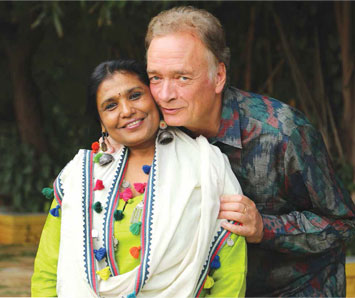
Rune: I had one that I remember clearly: I wanted an international life. In that I am much fulfilled, beyond expectations.
My childhood was spent in three countries. I am a Norwegian born in Norway; I spent my childhood in Norway, the United States and France. So, I grew up with these three cultures, which to a large extent still run in my veins. They have given me the opportunity to live a different life than the average Norwegian, as I had many more cultural and linguistic experiences than the kids with whom I played and went to school with.
Yes, probably, and this is because I have a very passionate relationship with the French language. I have lived almost half of my life in France and while working in Norway I taught French grammar at the university. Then I left Norway to teach Norwegian in France. After some time, I was called to be a diplomat in Paris and I thoroughly enjoyed this experience as well. That is when I met Sujata. One day, in 1989 I entered an exhibition at the international student campus in Paris where I was the director of an institution. Sujata also stayed at that campus. In fact, we were neighbours. She was a student scholar and a painter. The exhibition I just mentioned featured seven selected young international artists and Sujata was one of them. Three of her works were on the walls and I wished to acquire all three but just one was left to be sold. So, this is how I met the artist and I liked her as much as her paintings! In due course, I got her as well (not in that deal of course), but it all started at that exhibition, which I had randomly visited, with the purchase of the painting. We got married in 1991 and settled down in Paris. We simply love this city.
Sujata: It’s been 26 years of our marriage.
"Three of Sujata's works were on the walls and I wished to acquire all three but just one was left. So, this is how I met the artist and I liked her as much as her paintings! In due course, I got her as well

It was a very strange love at first sight, because at that time I was not so young. I was 35 years old and I lived in a place where there were lots of young people and students who hailed from different parts of the world. Norway House, where I stayed in those years, was next to India House. I would see young Indian women going in and out and at that time they did not dress in jeans-they all wore sarees or salwar kameez. I used to think they came from a very strange culture.
Then our friendship grew but there was this understanding that before we could consider taking it to the next level, Sujata insisted that I had to see her country. I came to India in 1989, met Sujata’s family and visited many parts of the country. India in 1989 was of course quite different from India today. I was curious and had at that time sufficient understanding, I believe, to grasp at least parts of the Indian culture. I was immediately attracted by some of the values there. Sujata’s parents Radhakrishnaji Bajaj and Anasuya Devi Bajaj were extraordinary people, not only in the way they welcomed me of course, but also in the way they conducted their own lives. They were historical followers of Gandhiji and firmly rooted in the principles that Gandhiji had laid out for the country. They were closely connected to Vinoba’s Ashram in Wardha, where I have stayed myself many times. Meeting Sujata’s family was a conclusive experience, if I may say so. It made it easy to consider a lifelong commitment
"Sujata's parents were historical followers of Gandhiji... They were closely connected to Vinoba’s Ashram in Wardha, where I have stayed myself many times. Meeting Sujata’s family was a conclusive experience, if I may say so. It made it easy to consider a lifelong commitment
There were things in India that I could not fall in love with. For the first time in my life I saw poverty. Remember, I come from a very egalitarian society where people by and large are treated equally in all matters. In India the opposite seems to be the rule. That was a shock for me. I had heard about strange beliefs, sacred cows, castes and all that but the scale of poverty was tough. It took me some time, I must admit, not to get too disturbed by this. However, India is such a great and grand country because of the marvels of its ancient civilizations. Many features of its glorious past are present in every day’s India. I am sensitive to that and I am truly grateful that I have been given the opportunity to know India and its culture. Sujata has remained very Indian. She has not moved into changing her core values unlike so many Indians today. I appreciate that.

Yes. We went back and after a year, in the summer of 1991, we decided to get married.
Rune: My parents were more reluctant than Sujata’s parents. I must confess that in my part of the world there were misunderstandings about India. At that time Norway was giving foreign aid to the country. India was considered poor and backward with strange customs and beliefs. This was the prevalent opinion. So, my parent’s attitude was naturally influenced by this. Since I was the only son, marrying an Indian girl made them initially a bit uneasy. In their view it was risky.
Sujata: Risky because they were insecure and had a biased view of our culture and of our country.
Rune: My parents were probably also less curious. We, young people are more curious. It was true then and it probably is even today. I was on the right side of this divide and they were most likely on the wrong side because of their age. It was not easy for them to even try to understand India. So, for my parents our marriage was quite challenging to accept, I must admit that
Sujata: But they came to India to attend our wedding and after that they were very happy.
Rune: Yes, they came to our wedding in Pune and they were very favourably impressed with everything.

The hospitality of Indians is on a different level because I believe, India is still very much a family based society while Norway is no longer that. We rely on the Government and our support system today is public welfare schemes. In India the family is there to help. This is a major difference. When you enter an Indian family, the family sees it as a duty to welcome that person, because I think Indians understand that when a foreigner comes to India he or she faces a very unfamiliar situation. When a foreigner comes to Norway it doesn’t matter because the society is such that there is no trouble and everything is functional and smooth sailing. You don’t need help to buy a train ticket whereas in India it can be very challenging for a foreigner to buy a train ticket without help. I have always felt that the Indians in general - particularly Sujata’s family with their strong Gandhian values - are extremely welcoming. But this is at the individual level. At the level of the society, Norway is very welcoming. Sujata was for instance fantastically well received as an artist. She has had a host of very successful shows both in Oslo and in Stavanger and there are hundreds of works of Sujata adorning walls of Norwegian homes that testifies to this. These days a prominent Norwegian art critic is writing a book on Sujata.
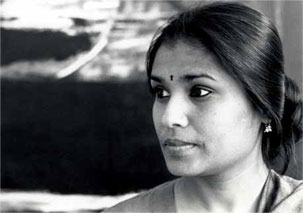
Well, there are some aspects I would like to underline which might not be too common. Sujata and I work together, we travel together and actually live in countries in which we both are considered foreigners. This creates special bonds. And there is of course our daughter, Helena, and the time we both take out spending with her. The three of us have a common passion in traveling and we make it a point to go on trips together. Last year we were in Japan, this year in Peru. Personally, I have become more interested in art over the years and I have taken a keen interest in Sujata’s profession to the extent that I have made it partly my own profession. Not that I am creative but there were quite a few technical aspects that I could take care of and thus free up time for her to paint. Now we spend a lot of time in France which is a country we both love. Paris is a beautiful city and has been a blessing for us.
Sujata is a vegetarian like her family and I am personally convinced it is the right answer – both, for our health and for the benefit of our planet. I am brought up differently, as a fish and meat eater like all Norwegians, but I have reduced significantly eating non veg, as you Indians say. I have compromised without feeling that I have sacrificed anything at all. I must add that we travel a lot so I do get opportunities to eat other things whenever I wish.
Sujata: Rune has made a serious effort. When we decided to get married, my mom wondered how I would cope as I had never eaten nor cooked non-vegetarian food. Being pure vegetarian is the rule in my family so this was an important point.
Rune: Languages play an important part when you have a background like ours. Helena was born and brought up in France. She speaks French and English fluently. With Sujata she speaks mostly in Hindi.
Sujata: Yes, she speaks Hindi beautifully…
Rune: Yes, she does. And that is a big achievement. The credit goes to Sujata. She has insisted that Helena learns Hindi. Many Indians are surprised when they hear how well she expresses herself in Hindi, especially in Mumbai where youngsters of her age tend to speak English.
Indians understand that when a foreigner comes to India he or she faces a unfamiliar situation. When a foreigner comes to Norway it doesn’t matter because the society is well-organised
The upbringing should aim at trying to make the child understand the best values of the father and mother by balancing the importance of both. We wanted Helena to be a tolerant person, accepting people of different races and creeds. She respects Hindu traditions, so we celebrate Hindu festivals and she follows them gladly. We also celebrate Christmas since I am a Christian. We try to give her a broad mind-set. And, we want her to be not just our daughter, but also our friend. I think we have managed this quite well. Now that she is 22 she speaks to me as a friend. She shares things with us that we believe not so many people of her age would share with their parents.
Technology is everything today and things are moving very fast as we all know. When it come to this, children often know more than their parents.
It is the first time in history that important technological knowledge is in the hands of children rather than in the hands of their parents. This has a profound impact on relations between generations and on how you bring up your children. I know many people who can no longer communicate with their grand-children because they cannot handle the technology and that becomes a pain point. In India you probably feel an even bigger pain because you still live in a system where one must respect the elders. However, after some years, even in India, youngsters will stop respecting their elders because they are not so techno-savvy.
I think parents should to be close friends of the child because the emotional highs are not what they used to be-the identity the child creates is now very much related to Facebook, to Instagram, to Snapchat and this is disturbing the children. The child has a friend one day and then there is a message on the phone that breaks this friendship and the child seeks for a new friendship once again. I think parents must step in and spend real time with their children. The friendship we have with our daughter is valuable because we see that this makes her differentiate the relationship she has with her friends and schoolmates. We are constantly in touch with her; we get calls from her saying, `‘Oh, I am so unhappy because this happened, because that happened and so on.’’ I have regular WhatsApp calls with her, we have been using these devices and we have to because she is in New York and she is happy with this kind of communication.
"The definition I think is that happiness in marriage, is not a right that you have; it is something you actively build. Many young people, if they look good, think that they have the right to happiness because in movies you see it like that
Rune: The definition I think is that happiness in marriage, is not a right that you have; it is something you actively build. Many young people, if they look good, think that they have the right to happiness because in movies you see it like that. But, this is not the real world. Happiness is a precious state of mind that both the spouses have to know how to identify, appreciate and how to build in interaction with each other. Secondly, where there is life there is change. We have to understand that we will all change over the course of time and that your partner will also change.
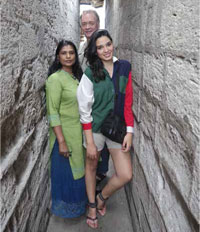
Artistic people have strong opinions and they live in a different world, largely of their own making. They can allow themselves to work and think differently. Other people have to relate to so many formalities, on the work place and in society. We have a boss, a secretary, assistants, partners; while artists have only their own work to do by themselves, at whatever time they would like to. So, at times artists can be really complicated to relate to, because they don’t share the standard codes of standard social behaviour
The Yoga centre that I created five years ago is something that I wanted to do for a friend to start with. Sujata and I have some very good friends and one in particular who is very dear to us and who has dedicated his entire life to help other people. He is very skilled as a yoga teacher, in fact, he is extraordinary I would say. Six years ago we could establish our own centre. Technically I am the boss, but he runs it, I am very happy with that.
Sujata: The centre, which has the best features and an excellent location, has the lowest fees in Paris. The students are very dedicated. Our friend gives attention to each person’s need. I think you could say that our yoga centre is idealistic and very person-centric.
Rune: Yoga became a big thing in the western world even before Mr Modi’s efforts to make an International Day for Yoga. It is still gaining momentum.
I do Yoga but not the complete set of exercises I have some limitations I cannot go fully into that. I was interested in some of the spiritual practices of India since my first visit to the country and particularly some of the meditation techniques that are thought to be developed by the historical Buddha. One such technique is called ‘Vipassana’. I do a course every year and I am very happy with that. It is 10 days in complete silence; waking up at 4 a m, eating little food. I take it as a challenge.
Peaceful. And thankful that such a technique exists and that I have the possibility to follow courses. After a course, you feel light in the body because you eat healthy for 10 days. You lose weight. You lose lot of mental weight also of course and that is the purpose. You understand that you should not indulge in all the petty things in life. We all have a tendency to create problems because of small things in life; Vipassana teaches you to see the bigger picture and to remain in the bigger picture while being non-reactive to things and events around. All the misery of the world happens because people react to things and do so in a wrong way; some reactions of course are necessary when there is danger, but most reactions are unnecessary.

Very simple: do not harm, try to do good and purify your mind. On a worldlier level, I think it is very important to be aware of the food we eat. It should be healthy because today we have all the knowledge we need for that. For educated people there is no excuse. I believe we have a greater responsibility towards our own bodies and our own health today than before. And the health of our planet is also linked to our food habits. So this issue is really an important one. We need to be equally vigilant with our mental health. Today we are aggressively bombarded with information. To find moments of mental silence is difficult, but it is necessary.
Rune: Sujata and I love the island of Santorini, Greece. It has a the most stunning view of the Mediterranean you can think of. We go to this island each year; to the same hotel where we stay in the same room-a very simple and basic room. The owners have become our friends. This is one thing which is very dear to us. Apart from Santorini, Sujata and I are very happy to travel to Thailand which is a recent discovery for us. We really enjoy the people there, their smiles, their politeness, the abundance of fresh fruits at all seasons and of course the beautiful flowers.
From her days at Ecole des Beaux Arts, in Paris, where she experimented with the mixed media to her studio in Norway and her home in Pune, Sujata Bajaj explores various materials, medias and methods. She has worked with different art forms and media such as etching, wood-cut, sculpture, murals, cold ceramic, fibre-glass, metal, mixed media and, now, acrylic. Sujata was in India recently to showcase her monumental work on the theme 'Ganpati' manifested through paintings and sculptures. Corporate Citizen caught up with this vibrant artist whose work has won international acclaim through various awards making India proud of her
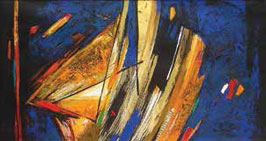
She can be quiet and contemplative, but also vivacious and spontaneous- dwelling on thresholds of sensitivity as it were. She lives between Paris, India and Dubai. Her husband Rune Jul Larsen is Norwegian. That takes her also to Norway. Unapologetic about her convictions and beliefs, she always carried India as well as her cosmopolitism wherever she is. Like her work, she is difficult to distil in words. Which is why it is easier to let Sujata Bajaj walk us on the promenade of time, let her unleash her memories-of colour, of childhood, influences of Ganpati and the essence of her life, juxtaposed against her work.
Pune girl Sujata Bajaj has grown to be a stalwart international artist today. She held her first show at the tender age of 19 years at the Bal Gandharva Art Gallery, Pune in 1978. At one of her subsequent exhibitions in the 1980s, S H Raza, one of India’s priciest artist who lived in Paris (he passed away in 2016) described her as, "one of the best young talents around, someone who is very clear about her concepts in art."
In 1988, Sujata went to Paris at Raza's insistence. She was awarded a scholarship by the French Government. In Paris, she enrolled at the Ecole Nationale Superieur des Beaux-Arts, and worked at Studio Claude Viseux. She got exposure to a unique technique, the monotype, which over time became her signature mixed media technique.
France also proved to be a fascinating world for Sujata, one that helped her "find the balance between Indian aesthetics and modern painting."
Indian tribal art plays a major role in Sujata's work even today. Quite natural given the fact that she did her PhD degree in Indian tribal art and has lectured on it across the world. Art critic Ranjit Hoskote, while reviewing Sujata's work says, "Each of her frame acts as a variation on the past, the ancestral inheritance: in the ochre yellow and red palette, we are recalled into the ritual circle of sacrifice; a hero-stone, a tribal totem, a lost goddess of fertility is suggested by certain motifs; and in the elegant calligraphy of the sacred texts, the hymns repeated until the pitch of perfection has been achieved."
Sujata Bajaj spends her time between India, Paris, Dubai, Norway. She’s an Indian by the clothes she wears, the food she eats and the way she paints, seated cross-legged on the floor. Through the window she sees the tree-tops and the sky. "It is a way of conserving a link to the earth,’’ she says. "It is also a way of meditating. I forget everything, except the canvas."
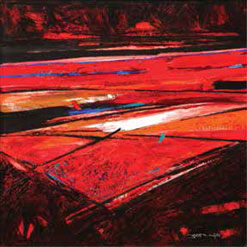
My parents played a monumental role in my life. I inherited a strong sense of freedom and security from Ma. In fact, I would sometimes cry at the thought of leaving India for Paris and she would say, `Why do you cry? If your roots are solid, you can live anywhere. Don’t start comparing; take whatever is good, wherever you are and think of both India and Paris as the front and backyards of your home.' From my father, Radhakrishnaji Bajaj who worked till he was 100 years old, I got my conviction and my passion. In Pune, while doing Fine Arts, drawing portraits wasn’t something I enjoyed very much. A teacher pointed it out through my less than satisfactory grades. That day I decided to draw a head every day before I ate anything at all. Later on in life, I would also take to eating only grapes for ten days in the month of September. I still do this even though I don’t particularly like grapes but I suppose this cure really shapes my will.
My siblings and I had a strong Gandhian upbringing. It was not an affluent childhood, but one that was rich in experiences. Our house was a hub of very eminent people. The famous reformer and philosopher, Kakasaheb Kalelkar would often visit us. And it was like a ritual between the two of us. He would always tell me a story on his arrival in Wardha and another one while leaving. There was Vinoba Bhave, the father of the Bhoodan movement who was like my own grandfather. He would make drawings for me and call me Chitrakarini (artist) and made sure I loved the verses of Bhagwad Gita. Jayaprakash Narayan (JP) would visit us too.
We were five siblings. I was the youngest. Our home was wonderfully tolerant and I never knew of any distinction of gender, caste or religion. My father was a social worker and was most of the time very busy but my mother was always with me. I learnt simple values but I also came to know what it meant to be free and understood. Those days we didn’t go to bazaars to buy things; we made it with our own hands. Surprisingly, today my daughter Helena does it the same way. She does not buy presents for us for her friends but makes something herself, which makes it special and personal. No wonder she became a designer
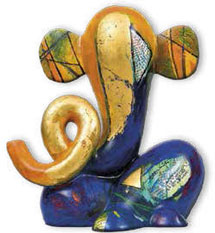
I am the way I am and I live the way I am. Essentially, I am an Indian. But today I feel deeply that France and Norway are equally prime colours in my palette. I also live within these cultures. I was able to live in France the way I wanted thanks to the French acceptance of the individual’s right to individuality There you can be what you are and never feel judged. The critical mind of the people of France, its intensity, its unwillingness to compromise on details, its permanent striving towards perfection I get that from France. Norway, on the other hand gives me the ability to draw inspiration from nature. There, I can spend my days looking at the sky and the ever-changing clouds. I have received a lot of appreciation for my art in Norway and the beauty of the land and its peace has instilled something valuable within me. I have also made some very good Norwegian friends that keep my ties to the country alive.
Red. It denotes all aspects of human life-it is the colour of love, of fire and passion, of blood, of volcanic energy and spirituality- he colour of the universe at its beginning. Red is such a powerful colour. But it has to emerge from darkness or else be just another patch for me. It will not have the same intensity unless it comes from black and has its support. So, I also use a lot of black. It offsets the red; gives it a lot of vitality.
"Red colour denotes all aspects of human life − it is the colour of love, of fire and passion, of blood, of volcanic energy and spirituality − the colour of the universe at its beginning. Red is such a powerful colour. But it has to emerge from darkness or else be just another patch for me
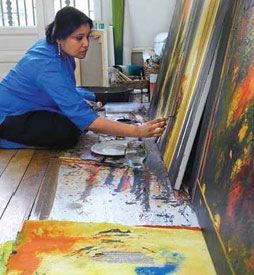
Unquestionably,my family! My parents gave me both security and independence. I could happily choose to walk my own path without worrying about lack of support if I chose something they wouldn’t approve of. Even my husband has always been very supportive of my life and work as an artist. I bounce ideas off him and go to him for counsel and critiqe. When my daughter Helena was little, she knew she must not disturb me when I was painting. She would sit and watch me working. The next time she would bring along her own colours. I’m happy to say she has, over the years, developed a strong sense of line and colour herself which bodes well for her career as a designer. Perhaps, it is in her DNA, as we would say today Sometimes, when I look at her work more as a critic, I’m surprised how mature her aesthetic sense is and how effortlessly she responds to colour, texture and form. In fact, being her mother has nourished me artistically and inspired me. Our cat, Nicy, is my quiet companion through my work, sometimes even up to the early hours of the morning, never intruding or scratching…but simply sitting by my side. I wouldn’t be where I am today but for the constant encouragement, support and appreciation family and friends have given and continue to give me.
As you know I have used Bhojapatra or the white paper-like bark of the Himalayas birch tree-in my mixed media. My mother collected it up in the mountains in 1948 when she walked with Gandhiji’s bhasma visarjan varta-the journey undertaken in the Himalayas to disperse Gandhiji’s ashes. She gave me these precious pieces in 1980 and told me to make good use of them since they carried a very special, positive energy. I used some of the bhojaopatra over 20 years ago and now I have used it again in the current work on Ganpati.
Then in 1981, I went myself to the Himalayas. While I was visiting the temple of Triyuginarayana, I saw many hand-written pieces of paper on the temple walls and I was instantly attracted to them. The priest of the temple helped me collect a good number of these papers, which I have used in my etching collages. These are said to be wish-fulfilling papers. And I can tell you that my wish-to get those papers so that I could use them in my work-has, indeed, come true!
Ganpati is supposed to be everywhere and nowhere, appearing and disappearing, and yet his prototypical form-half elephant, half human-is not realistic, rather it is surrealistic. Therefore, abstraction is the right artistic take on it, it is justified.
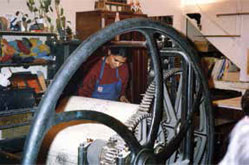
I found my artistic vocabulary and language in Paris, where I truly started my journey as an abstract artist. At the time, I realised I did have something special when it came to doing lines with such spontaneity. What was it that gave me such an obedient wrist? I can, probably trace it to my college years in Pune and my teacher M R Kelkar, himself a good artist. He had noticed my work. I had asked him for guidance. The next day he came home where I was living with my brother’s family with a 1000 large sized sheet of paper and six pencils and said to me, "You will draw vertical and horizontal lines till they are as straight as a ruler. You are not allowed to use ruler on the eraser. I will come back in a month or so to check and only when you get them absolutely straight will we start to work together." There was no way I could achieve this, I said to myself. But I sat down and started drawing straight lines, horizontal and vertical ones, trying to make perfect squares, month after month, for four months. And I did it. What an intense experience that was! And it has given me such an immense freedom in my strokes and lines.
By Vinita Deshmukh